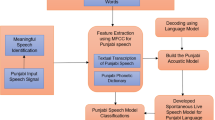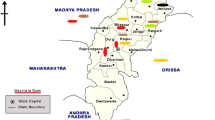Abstract
Automatic speech recognition is the central part of the wheel towards the natural person-to-machine interaction technique. Due to the high disparity of speaking styles, speech recognition surely demands composite methods to constitute this irregularity. A speech recognition method can work in numerous distinct states such as speaker dependent/independent speech, isolated/continuous/spontaneous speech recognition, for less to very large vocabulary. The Punjabi language is being spoken by concerning 104 million peoples in India, Pakistan and other countries with Punjabi migrants. The Punjabi language is written in Gurmukhi writing in Indian Punjab, while in Shahmukhi writing in Pakistani Punjab. In the paper, the objective is to build the speaker independent automatic spontaneous speech recognition system for the Punjabi language. The system is also capable to recognize the spontaneous Punjabi live speech. So far, no work has to be achieved in the area of spontaneous speech recognition system for the Punjabi language. The user interfaces for Punjabi live speech system is created by using the java programming. Till now, automatic speech system is trained with 6012 Punjabi words and 1433 Punjabi sentences. The performance measured in terms of recognition accuracy which is 93.79% for Punjabi words and 90.8% for Punjabi sentences.





Similar content being viewed by others
References
Alhawiti, K. M. (2015) Advances in artificial intelligence using speech recognition. International Journal of Computer, Electrical, Automation, Control and Information Engineering, 9(6), 1439–1442.
Ankit, A., Mishra, S. K., Shaikh, R., Gupta, C. K., Mathur, P., Pawar, S. (2016) A survey paper on acoustic speech recognition techniques. International Journal of Recent Advances in Engineering and Technology, 7(7), 2347–2812.
Bhardwaj, B., Kumar, D. (2016) Free Model speech recognition system using MFCC model. International Journal of Innovative Research in Computer and Communication Engineering, 4(5), 10065–10073.
Hoesen, D., Satriawan, C. H., Lestari, D. P., Khodra, M. L. (2016): Towards robust Indonesian speech recognition with spontaneous-speech adapted acoustic models. Procedia Computer Science 81, 167–173.
Kumar, Y., Singh, N. (2015) A first step towards an automatic spontaneous speech recognition system for Punjabi language. International Journal of Statistics and Reliability Engineering, 2, 81–93.
Kumar, Y., Singh, N. (2016) Automatic spontaneous speech recognition for Punjabi language interview speech corpus. I.J. Education and Management Engineering, 6, 64–73.
Kumar, Y., Singh, N. (2016) An automatic spontaneous live speech recognition system for Punjabi language corpus. IJCTA, 9(20), 259–266.
Muda, L., Begam, M., Elamvazuthi, I. (2010) Voice recognition algorithms using mel frequency cepstral coefficient (MFCC) and dynamic time warping techniques. Journal of Computing, 2(3),138–143.
Narayanan, A., Wang, D. (2015) Improving robustness of deep neural network acoustic models via speech separation and joint adaptive training. IEEE/ACM Transactions on Audio, Speech, and Language Processing, 23(1), 92–101.
Patadia, J., Reshamwala, A. (2016) Feature extraction approach in emotional speech recognition system. International Journal of Advanced Research in Computer Science and Software Engineering, 6(5), 706–710.
Swamy, S., Ramakrishnan, K. V. (2013) An efficient speech recognition system. An International Journal, 3(4), 21–27.
Author information
Authors and Affiliations
Corresponding author
Rights and permissions
About this article
Cite this article
Kumar, Y., Singh, N. An automatic speech recognition system for spontaneous Punjabi speech corpus. Int J Speech Technol 20, 297–303 (2017). https://doi.org/10.1007/s10772-017-9408-2
Received:
Accepted:
Published:
Issue Date:
DOI: https://doi.org/10.1007/s10772-017-9408-2




